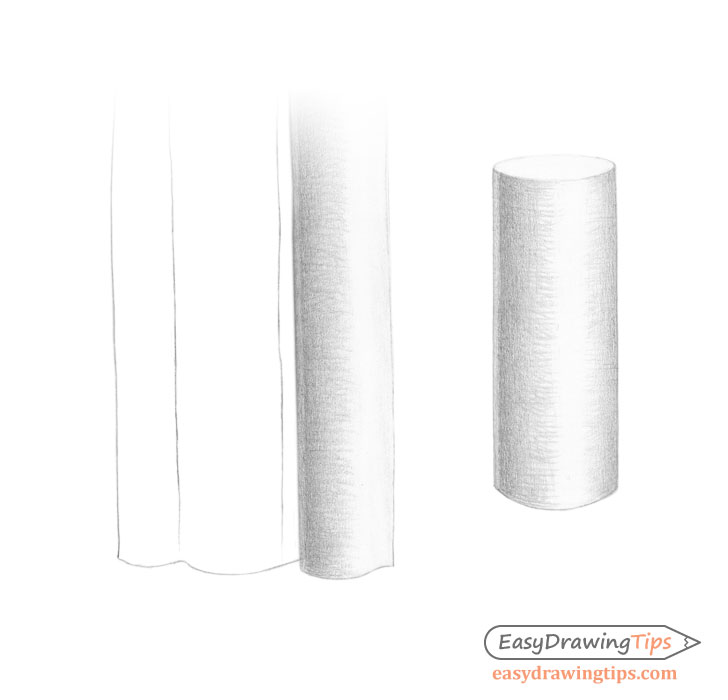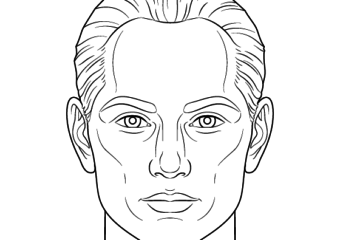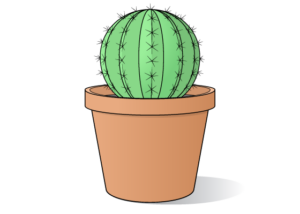How to Draw Cloth Folds Step by Step Tutorial
This step by step tutorial shows how to draw cloth folds. It provides explanations of three different kinds of folds with line drawing and shading examples.

Cloth folds can be fairly challenging to draw due to their seemingly random shapes. To help this tutorial provides an explanation of how folds are likely to form based on the compression and/or tension applied to the fabric. It also shows how you can break parts of them down into simpler shapes. Finally it demonstrates how to shade the folds and explains how light and dark areas tend to be distributed.
Please note that the appearance of folds can sometimes change based on the type of fabric. For example very rigid fabric can create sharper looking curves. However for the sake of this tutorial we will be using fairly common and soft fabric.
Also note that while these instructions focus on pencil shading most of the tips in this tutorial can still be applied even if you wish to draw in other mediums.
Part 1 – Cone Folds Drawing
In the case of hanging cloth the tension is usually created by the cloths own weight pulling down from where it’s attached to something.
Being attached to one small point a piece of cloth like the one in the examples below will tend to create folds with cone like shapes. Basically folds that get wider as they go down.
Step 1 – Cone Folds Line Drawing

To start the actually drawing process make a light line sketch of the cloth. You can either use your own piece of cloth reference or use the provided example.
Step 2 – Cone Folds Shading

In the above example you can see how shading parts of a piece of cloth is somewhat similar to shading a cone. However unlike a single cone the cloth folds will also cast both shadows and light reflections on one another.
To better understand how the light and dark areas are created and how the shadows are cast we should analyze the lighting conditions that the cloth is hanging in.
In this case the light is coming from the right side of the drawing and slightly to the front of the cloth. This means that the lighter areas will be on the parts of the cloth that are facing in that direction and the darker areas will be on the parts that are facing away from it. As the curves are fairly smooth the transition between the light and dark areas will be gradual as well.
The drop shadows will be cast opposite of the light source (to the left in this case).
For more on drawing and shading simple shapes see:
How to Shade Basic 3D Shapes Tutorial

For the actual shading process try and apply the pencil strokes it in a way that reinforces the shape of the cloth.
Make either slightly curved strokes or sets of fairly short straight strokes that wrap around the curves of the fabric. Afterwards apply another set of similar strokes but in a slightly different direction to create a crosshatch.
For more on different stroke types see:
Shading Techniques and Stroke Types Drawing Tutorial
As was mentioned earlier the folds will cast shadows and reflections on the other folds. In this case the first fold on the right will cast a shadow on the fold to its left. This fold will in turn cast a shadow on the next fold.
The reflections will be the light bouncing off of one fold to illuminate an area on another fold.
For example the fold on the right will have a very thin light area on its left side created by the light being reflected from the middle fold. The middle fold will have a barely noticeable light area on its left caused by the light reflecting from the left fold.
Step 3 – Cone Folds Finished Drawing

To finish the drawing gradually apply more overlapping sets of strokes to darken the shaded areas and to smooth out the overall surface of the cloth.
Try and avoid completely blending the strokes to the point of invisible. As mentioned earlier the direction of the strokes can help reinforce the shape of the curves.
Part 2 – Cylindrical Folds Drawing
Cloth that is evenly attached to one large area through it’s entire length and is squeezed together will tend to create cylinder/pipe like folds.
A good examples of this are window curtains.
Step 1 – Cylindrical Folds Line Drawing

The line drawing of cylindrical folds is fairly simple. Draw the main area of the folds with several sets of vertical lines. The appearance of the bottom of the folds will depend on the eye level of the viewer. Viewed from higher up the curves will appear rounder. If the bottom of the fabric is exactly at the level of the viewers eyes then it will appear flat with no curves. Finally if you look at the folds from below then the curves will go in the opposite direction.
For a more on how eye level effects drawing see:
Perspective Drawing Tutorial for Beginners
Step 2 – Cylindrical Folds Shading

These types of folds are probably the easiest to shade. The cylindrical folds as the name given to them in this tutorial implies can be broken down into cylinders. They will also be shaded accordingly.
For this example the lighting conditions are the same as the previous one with the light coming from the right side of the drawing area slightly in front of the cloth.
Also again keep in mind that the folds will cast shadows and reflections on one another. Both the shadows and reflections will be opposite the main light source.

Start the shading process by applying the strokes in curved or straight lines. Next follow up with another set of strokes at a slightly different angle to make a crosshatch.
You will notice that the fold on the very right of the drawing casts a shadow on the middle fold and also has a reflection from the safe fold on its far left.
As the middle fold is not as deep/round as the left side fold it will not cast as sharp of a shadow on the far left fold and will have no reflection from it either.
Step 3 – Cylindrical Folds Finished Drawing

To finish the shading apply more sets of strokes darkening in the in shadow and drop shadow areas of the drawing. Again try to not fully blend the strokes as visible strokes will help add some texture to the cloth and can give a better sense of the shape of its curves.
Part 3 – Multiple Tension Point Folds Drawing
Cloth that hangs from multiple points will tend to create “U” like folds in between the those points and cone like folds similar to the first example on the sides.
Another way to look at the shape of this entire piece of cloth is as the letter “M”.
Step 1 – Multiple Tension Point Folds Line Drawing

You will notice that this line drawing has more details then the previous two examples. This is to be expected from this type of a setup of more complex folds.
There is not much instructions to be given for this step other than that you just have to pretty much draw what you see.
Step 2 – Multiple Tension Point Folds Shading

As in the previous two examples the light in this one will be coming from the right side of the drawing and again slightly to the front of the cloth.
You can once again use either curved on straight strokes for the shading process. Straight strokes are used for the examples but they are still applied in a way that somewhat wraps around the shape of the cloth.
You will also want to yet again create a crosshatch by applying one set of strokes followed by another set of overlapping strokes at a slightly different angle.
Remember to be aware of the cast shadows and reflections. Generally the larger the folds the bigger the shadow they will cast. More pronounced folds will cast sharper shadows while smoother folds will cast smoother shadows.
Reflections will mainly happen on the curved sides of folds that face towards another fold. More pronounced larger folds will cast brighter reflections.
Step 3 – Multiple Tension Point Folds Finished Drawing

Keep on applying more sets of strokes to darken the shadows and to smooth out the gradients but don’t fully blend them. As already mentioned keeping some strokes visible will give the cloth more of a fabric like texture and the direction of the strokes can help emphasize the shape of the curves.
Conclusion
Cloth folds are fairly complex and depend on a variety of factors such the tension/compression of the cloth or even the type of fabric. It’s difficult to cover too many examples in one tutorial but the tips provided here should give you a good basic understanding of how to draw some of the more common types of cloth folds.
For more shading tutorials see:
Egg Step by Step Basic Shading Tutorial









